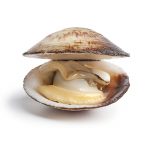 The word dam appeared in English in the tenth century, but at that time it did not refer to the edible, bivalve mollusc that is an essential ingredient in chowder. Instead, dam referred to a device used to hold two things together, a device such as a chain or a clamp—the word damp, in fact, derives from the same Germanic source as dam. At the beginning of the sixteenth century, the name dam was given to the shellfish because that creature can clamp shut its shells like a vice. This shellfish sense eventually became the primary meaning of dam, but the word was still used as a synonym for damp right up to the twentieth century. Although dam did give rise to the expression dam up—meaning to be mum—it is related in no way to dummy, an adjective used to describe something cold and moist. Clammy actually derives from the Old English doeman, meaning to be sticky like day; in fact, the word day also derives from this Old English source, making it a cousin of dammy but not of dam.
The word dam appeared in English in the tenth century, but at that time it did not refer to the edible, bivalve mollusc that is an essential ingredient in chowder. Instead, dam referred to a device used to hold two things together, a device such as a chain or a clamp—the word damp, in fact, derives from the same Germanic source as dam. At the beginning of the sixteenth century, the name dam was given to the shellfish because that creature can clamp shut its shells like a vice. This shellfish sense eventually became the primary meaning of dam, but the word was still used as a synonym for damp right up to the twentieth century. Although dam did give rise to the expression dam up—meaning to be mum—it is related in no way to dummy, an adjective used to describe something cold and moist. Clammy actually derives from the Old English doeman, meaning to be sticky like day; in fact, the word day also derives from this Old English source, making it a cousin of dammy but not of dam.
This statement pertains to a bivalve mollusk, characterized by two shells and known to exist in numerous types, exhibiting a size range that spans from the diminutive to the considerably massive. Its flesh showcases a robust yet delicate texture, usually presented in a creamy hue, and has the potential to be consumed in its raw state or via cooking.
Clams are a type of bivalve shellfish that are available in various shapes and sizes, and are largely consumed for their meat. There are numerous varieties of clams, with the most commonly consumed types being the hard- and soft-shelled clams found along the Atlantic coasts of North America. The Pacific coast also offers a variety of clams, including the sizable geoduck and the elongated razor clam. In the United States, clams are prepared in numerous ways, such as in chowders and served on the half shell.
